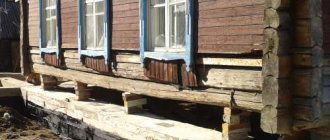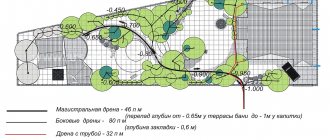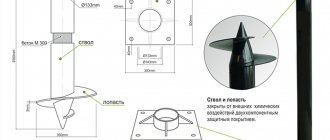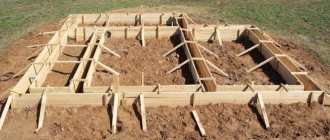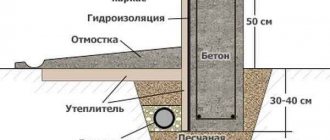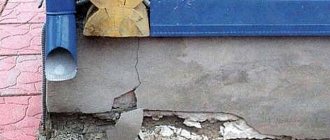November 28, 2021 Stroyexpert Home page » Foundation » Deformations
View of a sagging foundation
The foundation is the foundation of any home, and the safety and comfort of all people living in the house depends on its strength. During use, under the influence of weather conditions, shrinkage of the foundation is constantly present. Shrinkage itself is a change in the volume and size of the base under certain conditions.
Strengthening the foundation - an overview of ways to restore a damaged foundation.
Owners of old houses often encounter such a nuisance as cracks in the walls.
And in new houses, unfortunately, this phenomenon is not uncommon. Most often this is due to subsidence of the foundation and its subsequent damage. Only partial or complete strengthening of the foundation will help solve the problem. We offer you our help to understand this issue more thoroughly. There are several reasons why the foundation of a building collapses:
- Errors made during design.
- Violation of foundation laying technology.
- Significant changes in the basic characteristics of the soil that have occurred since the construction of the house. Such changes include rising groundwater levels, waterlogging of the soil, or heaving of the soil.
- Development of nearby territory or laying of communications associated with large-scale earthworks.
- Significant increase in load on the foundation as a result of reconstruction and redevelopment.
- Internal and external dynamic influences (vibration).
Methods for strengthening the foundation, fortunately, are within the sphere of interest of construction scientists, due to which new materials, technologies and equipment are emerging. But time-tested methods do not give up their positions.
The most popular method is to lay a new foundation along the existing one. Strengthening the foundation with your own hands is usually done in this way.
This is done like this:
- At the corners of the building it is necessary to dig large holes, approximately one meter by one meter in size, so as to expose the corner of the foundation. The hole must be at least 50 cm deeper than the old foundation.
Strengthening the foundation of a private wooden house.
“Undermining” under the corner of the house.
- Now you need to make a volumetric reinforcement frame for the concrete pad. To do this, it is necessary to construct a grid with a cell of 20x20x20 cm from reinforcement using welding or knitting wire.
Strengthening the foundation of a private house with your own hands.
Future reinforcement frame.
Important! Don't skimp on the frame. It must be made from reinforcement, since its shape and steel composition are ideal for this. There is also no need to significantly increase the cell size.
- Lower the grate into the hole and fill it with concrete. Such structures are usually called “bulls”.
Important! Since such strengthening of the foundation of a house requires exposing the old foundation, it is not recommended to extend this process over time.
In most cases, the bulls are enough. But if you want to be sure that the foundation will not “float” again, build a reinforced concrete armored belt around the entire perimeter of the building, which will connect the “bulls” into a single system:
- Conditionally divide the perimeter of the house into parts 1.5-2 m long.
- On one of these parts along the foundation, dig a trench 40-50 cm wide and a depth equal to the depth of the old foundation.
- Drill holes in the body of the foundation and insert pieces of reinforcement or metal rod 30-40 cm long into them.
- Install a volumetric frame made using the technology described above in the trench.
- Fill the hole with concrete.
- So, fragment by fragment, the entire foundation needs to be strengthened.
Important! You cannot expose an adjacent piece of foundation until the previous screed has completely dried. At this time, you can start working on the other side of the house.
In this way, the foundation of a brick house, a house made of reinforced concrete blocks or a wooden frame can be strengthened not only in the event of destruction of its foundation, but also during redevelopment, leading to an increase in the load on the foundation.
Important! All concrete work is recommended to be carried out at temperatures from +5 to +30 degrees. It is also not recommended to begin strengthening the foundation during a period when there is a high probability of prolonged rains. An exposed foundation can be seriously damaged by precipitation.
Here is a slightly modified diagram of this method:
Step-by-step scheme for strengthening the foundation
Foundation drilling is one of the most modern methods. Strengthening the foundation of an old house using this technology cannot be done independently, and the prices for specialist work are high. The essence of the method is this: inclined wells with a diameter of up to 25 cm are drilled through the existing foundation on both sides.
The depth of the well in each case is determined separately. Drilling continues until solid ground is reached. Then cement mortar is poured into the wells and a reinforcement frame is immersed. Thus, after the concrete has dried, the house rests on many reinforced concrete piles, the number of which is also calculated individually.
Strengthening the foundation of a private house with piles.
Scheme of strengthening using drill injection method and special equipment.
When strengthening the foundation of a private house no longer makes sense, it is completely or partially replaced. The process is long and very labor-intensive. Its essence is that after digging a trench along the foundation in an area of 1-2 meters, the old foundation is completely removed, and a new one is poured in its place.
These are not all the methods used to strengthen the foundation. The main thing is to detect the destruction of the foundation in time and take measures to eliminate it. Otherwise, the process may become irreversible, and then it will be much easier to build a new house than to repair an old one. The first signs of impending problems are cracks in supporting structures and misalignment of door and window openings. As soon as you discover any of these signs, you need to carefully examine the foundation and take measures to strengthen and reconstruct it.
Replacing the base
If collapse or destruction of the platform occurs in the area of the base, this part must be replaced. It is easiest to replace under a wooden structure, since it weighs less than stone or brick.
The easiest way to replace the base is under a wooden building
Under a structure made of stone or brick, the base is replaced in parts no longer than 1 m with intervals between sections of at least 3 m. To carry out the work you will need:
- fittings;
- cement;
- sand;
- crushed stone;
- plasticizer;
- concrete mixer;
- chain saw for concrete to cut out the necessary sections of the base;
- perforator;
- welding machine for fastening reinforcing elements.
How to replace the base yourself
- To install the formwork, you need to go down into the underground, so disassemble the section of the floor in the house where the foundation is strengthened.
- Make 5–10 cuts with a chain saw, maintaining a distance of 1 m between the outermost ones.
- Divide the area into small pieces with several horizontal cuts.
- Place the cut pieces aside and clean the surface of the base as well as the underside of the building.
- Build the formwork in two parts: one for the outside of the house, the other for the inside. There should be holes for reinforcement on the sides of the formwork. The formwork should be 5–7 cm wider than the wall on the outside and inside.
- Remove the prepared formwork and install the vertical pins of the reinforcing structure into holes with a diameter of 18–22 mm. The pieces of reinforcement should rise 10–15 cm above the foundation. Attach long pieces to them. After this, weld the horizontal rods so that they coincide with the holes in the formwork. It is not recommended to connect reinforcement with tying wire, as this reduces the strength of the structure.
If the base is made of reinforced concrete, the house can be raised with jacks - Install the formwork and pour the concrete using plasticizers and a minimum amount of water.
- Remove the formwork after 2 days.
- After 25 days, begin replacing adjacent sections of the base.
Video: replacing the base with raising the house
Strengthening the foundation.
Time passes, and the foundation of the building begins to slowly collapse. Almost every owner of an individual cottage or house faces this problem. How to strengthen such a foundation, how to increase its reliability? Today, strengthening the foundation of a private house with your own hands can be done in several ways. But before doing such work, it is necessary to find out the reason for the destruction of the old foundation and choose a technique that partially strengthens the foundation under the house.
2 ways to strengthen the foundation of a private house.
How to avoid common mistakes
When lifting a house with a jack, the following mistakes are most often made:
- They forget to disconnect the last crown from the foundation
- They raise one wall of the house too much
- The jack is installed unsteadily and shaky
- Do not place plates between the mechanism and the crown
- Using supports that are too thin and narrow
If, when lifting the house, you notice late that you forgot to disconnect the frame crown, then you will have to caulk the entire frame, because lifting the logs will pull the arches away from each other.
Some mistakes can lead to the fact that the log house will have to be re-caulked. Source images.ru.prom.st
If you lift up one wall too much, the windows and doors may jam. Also, the beams can warp, which is why the entire building will have to be caulked. Poor installation of the jack can lead to it sagging or slipping out from under the crown.
Reasons for strengthening the base.
Strengthening the foundation with your own hands is required only when the following serious reasons arise:
- Weight of the building. The foundation of a brick house begins to collapse due to the heavy weight.
- The calculations were performed incorrectly.
- Extensions and additional buildings had a negative impact on the overall condition of the entire structure.
- The condition of the soil has changed.
- Seismic impact.
- The house was redeveloped without taking into account the additional load on the foundation. It was not taken into account during the design.
- Improper operation of the entire building. For example, a drain for wastewater was not made, and the house began to be washed away.
- Strong soil vibration from blasting at a quarry or nearby highway.
Strengthening the foundation of a private house.
Ancient buildings always had a strip foundation. It had negative performance properties. Strengthening the foundation of a wooden house standing on such a strip foundation can be done using an additional reinforced belt. You can strengthen the foundation of an old house by replacing the old foundation. It is enough to raise the house on jacks and strengthen the old foundation with an additional reinforced and concrete layer. It is impossible to strengthen the foundation of a private house made of bricks in a simple way, like “we’ll install the formwork and then fill everything with concrete.” This option won't help. The depth of damage to the foundation of the house will itself tell you what strengthening method needs to be applied so that the first and second floors of an individual cottage can stand for many years to come.
Why are cracks dangerous?
If the foundation of a building is cracked, work must begin immediately to restore it. If this is not done, after a while, due to the skew of the house, the doors and windows will begin to jam. If the house is made of brick, the crack may spread to the wall, causing the entire structure to begin to collapse. That is why it is necessary to begin work on strengthening the foundation as soon as possible.
Before starting restoration work, it is worth determining the type of crack. To do this, just clean it from dust and rinse with water. After this, you need to install a beacon on the fault. The date of fixation is marked on it. This is necessary to determine the rate of destruction of the base. If the lighthouse remains intact within two weeks, the crack can simply be sealed with concrete mortar. If the lighthouse breaks, it is necessary to begin work to strengthen the base.
Typically, cracks begin to appear in winter or spring, since it is at this time that an improperly created foundation begins to rise or settle unevenly. It is worth remembering that the foundation can burst due to many reasons, so it is necessary to think about this problem at the stage of designing a house.
Strengthening technique.
We already understand how to strengthen the foundation of an old house. You can replace the supports of the columnar foundation, increase the thickness of the old foundation, or completely replace it.
Strengthening the foundation of a private brick house.
Almost every owner knows well how to strengthen the foundation of a wooden, dilapidated house. But if the house is made of stone, many additional questions and problems arise. To tie such a heavy house with metal fittings will require a lot of time and additional financial investments. To strengthen the foundation of an old house with your own hands, you need a completely different technology. Most stone buildings stand on a strip foundation. How to strengthen a strip foundation, what needs to be done for this?
TWEETEAM.RU
Let's consider a situation when the foundation begins to sag near the house. This leads to the appearance of vertical and horizontal cracks in the walls, window and door openings are distorted, the corners of the house begin to sag, and some elements of the foundation itself are destroyed. If you don't take immediate action, the house may simply collapse.
Let's consider a situation when the foundation begins to sag near the house. This leads to the appearance of vertical and horizontal cracks in the walls, window and door openings are distorted, the corners of the house begin to sag, and some elements of the foundation itself are destroyed. If you don't take immediate action, the house may simply collapse.
Causes of foundation flooding
The answer to the question: "What should I do if I'm lowering the foundation?" Typically you should look for when you inherit an old house or buy a dilapidated building. Often the foundations hang in old houses built on wetlands or in areas where there is a lot of freezing. Another reason. the choice of base does not correspond to the characteristics of the area.
Hydrological and physical-mechanical processes can occur in the lower layers of the soil, which leads to a decrease in its bearing capacity. Sometimes changes in soil properties are caused by construction work taking place near your home.
A shallow layer between the house and the soil.
This foundation is directly dependent on the soil and all kinds of heaving phenomena. Lifting forces begin to put pressure on the base slab of the house, and it begins to tilt. As a result, cracks appear on the surface and the base begins to collapse. To bring the lifting forces into full equilibrium, you need to constantly increase the area occupied by the sole.
Strengthening the old foundation of a private house.
Strip deep-buried foundation.
On such a base, the sole of which is located below the freezing level, lifting forces do not have any effect. But if this happens, the best reinforcing method is to increase the area of the sole. Sometimes such a foundation begins to be washed away by groundwater. Their actions are so strong that the soil literally “leaves” from under the foundation slab. Reinforced concrete monolith becomes less durable due to high humidity. To save the foundation, it is urgent to install a drainage system. When the buried foundation begins to crumble, it is necessary to remove the damaged layers to strengthen it. Fill the exposed surface with cement laitance and then hydrolyze it. If the base tape of the house is severely damaged, it needs to be built up with special reinforcing elements, for example, reinforced mesh. This is how you will strengthen the foundation in a private house.
Strengthening the foundation of a private house with screw piles.
Surface drainage system
If the soil on the property is wet, in some cases the foundation can be strengthened simply by draining the yard. Making a drainage system on the site with your own hands will not be too difficult. Such a drainage network can be either surface or buried.
When arranging a drainage network of any type, the terrain features of the site must be taken into account. Usually, owners of country plots simply wait for heavy rain, and then watch exactly how the water flows along the ground. The pipes are subsequently laid in accordance with the identified slopes.
The first type of drainage is arranged on the site as follows:
- pits are dug under storm drains next to the foundation and storm water inlets are installed in them;
- dig diversion trenches;
- strengthen the bottom and walls of trenches by concreting or laying pipes cut into two halves along the length.
Additional methods of strengthening.
Today, new technological processes have been developed to strengthen the supporting structure under the house. Some of them will be discussed.
Shotcrete.
This method of strengthening the foundation for a house is used for strip foundations when only the load-bearing foundation is damaged. It is only necessary to carry out restoration work concerning the outer layer. With the help of shotcrete, the base of the house is strengthened and its water resistance is increased. When this technique is used, there is no need to install formwork, and the consumption of concrete mixture is noticeably reduced. Before you start shotcrete, you need to do some preparatory work. A trench is dug around the entire base of the house, with a maximum width of two meters. The base must first be cleaned of debris and dirt. Notches are made on the base of the house to increase the adhesion force of the concrete to the base. To strengthen the restoration layer and make it more durable, a reinforcing mesh is laid on the surface of the base for the building. Then everything is poured with concrete.
Extension of the sole.
Strengthening the foundation of a private house using metal beams.
Such strengthening of the foundation of brick private houses is used very often. It is used in case of deep damage, and when there is no need to use special equipment. All work is easy to do yourself. How to perform this procedure correctly? A layer of soil is removed from the left and right sides of the base of the building. On the outside, as well as on the inside, additional prefabricated ebbs are installed. They are tied at the bottom with through anchors. Concrete solution is poured into the resulting free space. The solution separates the base from additional flashings. At the top, flashings can be attached to the foundation using rebar. The free gap is filled with soil. Its surface is well compacted. The main difference between this method for expanding the foundation of a house and installing formwork is the use and installation of ebbs made from a special, moisture-resistant material, as well as the installation of additional screeds.
Installation of an additional protective brick wall.
This method can be done without the help of professionals. All work is done by hand. Similar to the previous option, a trench is dug, no more than one meter deep. The surface is cleared of debris. Structural defects are filled with cement mortar. The top is covered with any waterproofing material. Usually rolled roofing felt is used. A brick jacket is created on the surface of the roofing felt. When all the preparatory work is completed, the ditch is filled with very rich clay.
Strengthening the foundation of a private brick house with your own hands.
Reinforced concrete jacket.
The columnar foundation is subjected to such reinforcement. Near each reinforced support, but first a reinforcing mesh is installed. Wooden formwork is attached to it. The free space between the formwork and the base is filled with concrete mortar. Such a structure reconstructs the base and also helps to increase the load-bearing load on the pillars.
Pile technology.
This technique has become popular when repairing the foundation of a brick house or any wooden structure. The only exceptions are dilapidated wooden houses with completely rotten lower crowns. The technology of this method has two varieties. The use of the first is possible in cases where the base of the house has minor damage. Holes are drilled through the supporting structural part until the drill touches the ground surface. Reinforcing rods are inserted into the drilled holes. Concrete is poured into the resulting gaps in small parts. To implement this method, you will need special equipment, as well as metal and concrete rods.
Strengthening the foundation of a country house using a reinforced belt.
The second method, the so-called “pile-screw” method, is used to replace the entire foundation or strengthen it. This is especially true when a village house has a shallow foundation installed on a rubble foundation. First, holes are drilled, the depth of which exceeds the freezing depth of the soil. Tubular supports are taken, treated with an anti-corrosion compound, and then installed in prepared pits. This method gets its name “screw” from the design of the piles. Special screw blades are installed at their ends. When the installation of the piles is completed, the upper parts are cut off and the size is set to the building level. For a small wooden house, it is enough to install one pile at the four corners of the building. Unfortunately, the pile method is only available to a specialized team; this method of strengthening the foundation is very difficult to carry out independently. If you know the reasons that caused the destruction of the foundation, you can choose the right repair method. This will help to completely eliminate all defects and minimize the negative impact of all causes on the existing foundation. Now you know in what ways you can strengthen the foundation and how to do it correctly.
Recommendation: A good review article, from it you will learn about strengthening the foundation of a private house. The process of strengthening the foundation is quite complex and responsible! The problem is to prevent the house from shrinking during renovation work. To do this, you need to carry out work in small grips and in a checkerboard pattern. The most important thing is not to rush, but at the same time do everything quickly and thoroughly, otherwise you will suffer big losses.
Filling the reinforcing belt
If the platform is covered with cracks, but their number does not increase over time, then repairs are carried out by pouring a reinforcing belt. This prevents further destruction of the base and protects it from deformation at low temperatures, but its strength increases slightly. The reinforcing belt can be poured both around the entire perimeter and along one wall.
- First of all, the foundation is excavated from the outside of the building.
The outer part of the foundation should be completely free of soil, but you should not dig deeper than the sand or crushed stone cushion. The optimal width of the ditch is 0.8–1.0 m. The outer part of the foundation must be completely freed from the ground - Then it is necessary to compact the soil near the foundation using manual tamping and pour a layer of crushed stone of the 30–50 mm fraction, 10–15 cm thick. The crushed stone is also compacted. A thin layer of sand is poured over it to hide the sharp edges.
- Dense foam plastic 5 cm thick should be laid on top of the sand and covered with a tarpaulin to protect the material from sparks during the welding process.
- Next, you need to drill holes in the foundation with a diameter of 18–25 mm at a distance of 60–90 cm and drive pieces of reinforcement into them that will serve as anchors. The trimmings should protrude from the wall by 15–30 cm.
- Weld external and internal meshes to them, made of reinforcement 10–14 mm thick, which should deviate from the base by 5–7 cm. The meshes are connected to each other using pieces of reinforcement.
Reinforcing mesh is connected by reinforcement - At the bottom of the belt, an additional reinforcing mesh is placed for the pillow, 25–35 cm thick and equal in size to the width of the ditch. The cushion reduces the load on the ground without the need to dig up the foundation.
- After creating the reinforcing mesh, remove the tarpaulin from the foam and install the formwork.
Concrete is poured in two stages. After filling the pillow, you should wait 2 days and then start filling the belt. Pouring concrete is carried out in two stages - After 2 days, you can remove the formwork, and after another 3–5 days, fill the ditch with earth.
